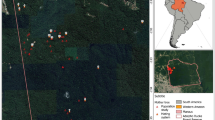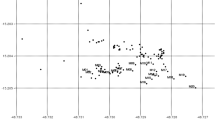Summary
Here we report the results of a mating system analysis of an Amazonian population of Bertholletia excelsa, a tropical rain forest canopy tree species. Using progeny data from 29 seed parents, two highly polymorphic isozymes were analyzed to derive single locus and multilocus estimates of outcrossing, based on a mixed mating model. The two single locus estimates were very similar, and both were somewhat smaller than the multilocus estimate, indicating the possibility that the populations are genetically structured. The multilocus outcrossing estimate (tm=0.85±0.03) reveals that outcrossing is prevalent, but that a significantly low level of inbreeding may be occurring. The high outcrossing rate indicates that even though dispersion of individuals is very low within populations of this tropical rain forest tree, pollen dispersal mechanisms appear to be adequate to enable crosses with a relatively large number of potential mates.
Similar content being viewed by others
References
Ashton PS (1969) Speciation among tropical forest trees: Some deductions in the light of recent evidence. Biol J Linn Soc 1:155–196
Bawa KS (1976) Breeding systems of tree species of a lowland tropical community. Evolution 28:85–92
Brown AHD, Allard RW (1970) Estimation of the mating system in open pollinated maize populations using enzyme polymorphisms. Genetics 66:135–145
Brown AHD, Matheson AC, Eldridge KG (1975) Estimation of the mating system of Eucalyptus obliqua L. Merit using allozyme polymorphisms. Aust J Bot 23:931–949
Buckley DP, O'Malley DM, Apsit V, Prance GT, Bawa KS (1988) Genetics of Brazil nut (Bertholletia excelsa). 1. Genetic variation in natural populations. Theor Appl Genet 76:923–928
Cheliak WM, Pitel JA, Murray G (1985a) Population structure and the mating system of white spruce. Can J For Res 15:301–308
Cheliak WM, Dancik BP, Morgan K, Yeh FCH, Strobeck C (1985b) Temporal variation of the mating system in a natural population of jack pine. Genetics 109:569–584
Clegg MT (1980) Measuring plant mating systems. BioScience 30:814–818
El-Kassaby YA, Ritland K (1987) Low levels of pollen contamination in a Douglas-fir seed orchard as detected by allozyme markers. Silvae Genet 35:224–229
Ellstrand NC, Foster KW (1983) Impact of population structure on the apparent outcrossing rate of grain sorghum (Sorghum bicolor). Theor Appl Genet 66:323–327
Ennos RA (1985) The mating system and genetic structure in perennial grass, Cynosorus cristatus L. Heredity 55:121–126
Ennos RA, Clegg MT (1982) Effect of population substructuring on estimates of outcrossing rate in plant populations. Heredity 48:283–292
Fedorov AA (1966) The structure of the tropical rain forest and speciation in the humid tropics. J Ecol 54:1–11
Hamrick JL (1982) Plant population genetics and evolution. Am J Bot 69:1685–1693
Huber J (1910) Mattas e madeiras amazonicas. Bol Mus Para 6:91–225
Kesseli RV, Jain SK (1985) Breeding systems and population structure in Limnanthes. Theor Appl Genet 71:292–299
Marty TL, O'Malley DM, Guries RP (1984) A manual for starch gel electrophoresis: New microwave edition. Staff Paper Ser No 20, Dept Forestry, Sch Nat Resources Coll Agric Life Sci, Univ Wisconsin-Madison
Moran GF, Brown AHD (1980) Temporal heterogeneity of outcrossing rates in Alpine Ash (Eucalyptus delegatensis R.T. Bak.) Theor Appl Genet 57:113–120
Mori SA, Prance GT (1988) Taxonomy, ecology, and economic botany of the Brazil nut (Bertholletia excelsa) Humb. & Bonpl.: Lecythidaceae). Adv Econ Bot (in press)
Moritz A (1984) Estudos biologicas da Castanha-do-Brasil (Bertholletia excelsa H.B.K.) EMBRAPA Centro de Pesquisa Agropecuario de Tropico Umido Documentos 29:1–82
Muller CH, Rodrigues IA, Muller AA, Muller NRM (1980) CaResultas de Pesquisa. EMBRAPA, Centro de Pesquisa Agropecudrio de Tropico Umida Mescelanea 2:1–25
O'Malley DM, Bawa KS (1987) Mating system of a tropical rain forest tree species. Amer J Bot 74:1143–1149
Ritland K (1985) The genetic mating structure of subdivided populations. Theor Popul Biol 27:51–74
Ritland K, Jain S (1981) A model for the estimation of outcrossing rate and gene frequencies using n independent loci. Heredity 47:35–52
Shaw DV, Allard RW (1982) Estimation of outcrossing rates in Douglas-fir using isozyme markers. Theor Appl Genet 62:113–120
Smyth CA, Hamrick JL (1984) Variation in estimates of outcrossing in musk thistle population. J Hered 75:303–307
Smythe N (1978) The natural history of the Central American agouti (Dasyprocta puntata). Smithson Contrib Zool 257:1–51
Ward RH, Sing CF (1970) A consideration of the power of the χ2 test to detect inbreeding effects in natural populations. Am Nat 104:355–365
Author information
Authors and Affiliations
Additional information
Communicated by P. M. A. Tigerstedt
Rights and permissions
About this article
Cite this article
O'Malley, D.M., Buckley, D.P., Prance, G.T. et al. Genetics of Brazil nut (Bertholletia excelsa Humb. & Bonpl.: Lecythidaceae). Theoret. Appl. Genetics 76, 929–932 (1988). https://doi.org/10.1007/BF00273683
Received:
Accepted:
Issue Date:
DOI: https://doi.org/10.1007/BF00273683




